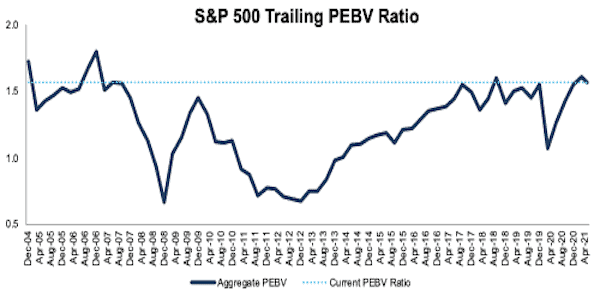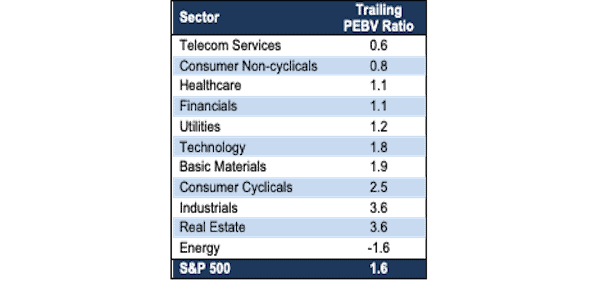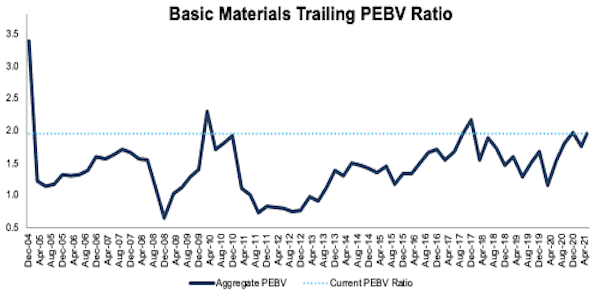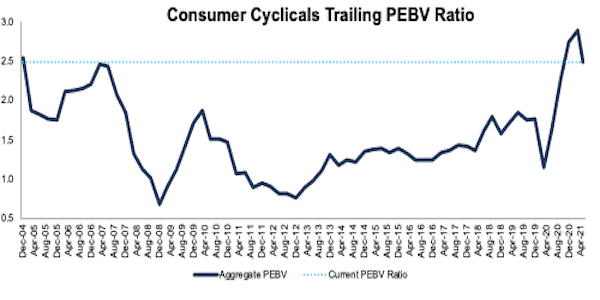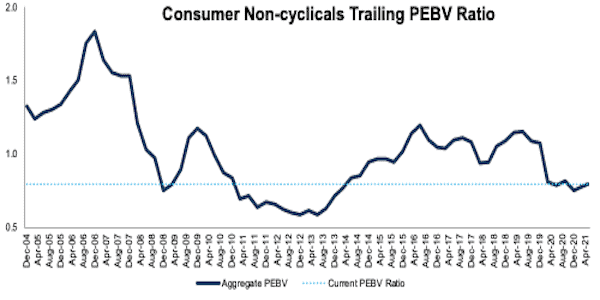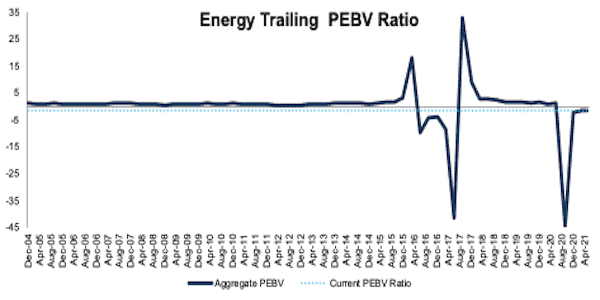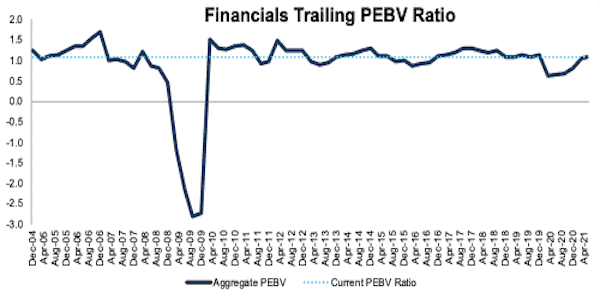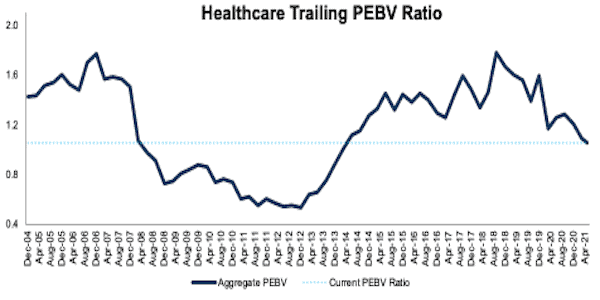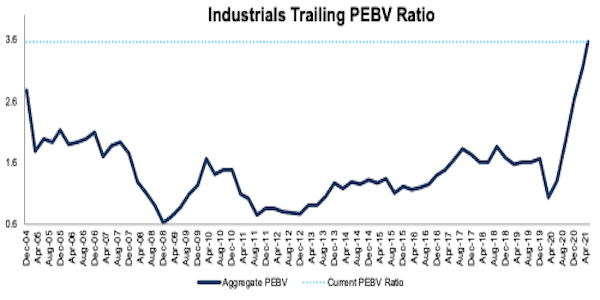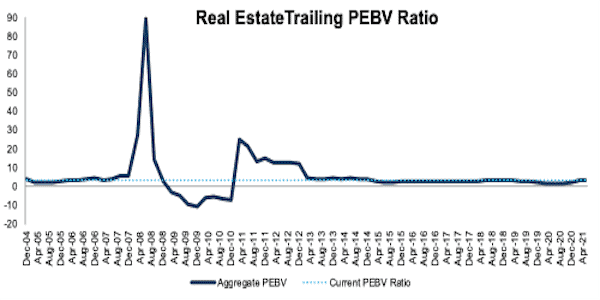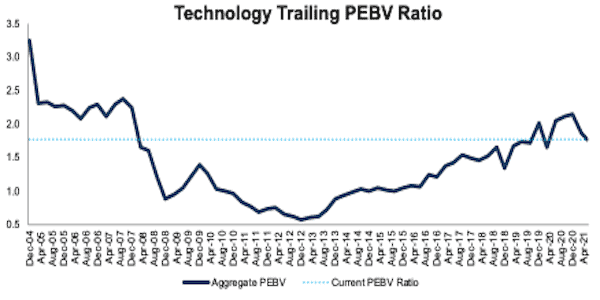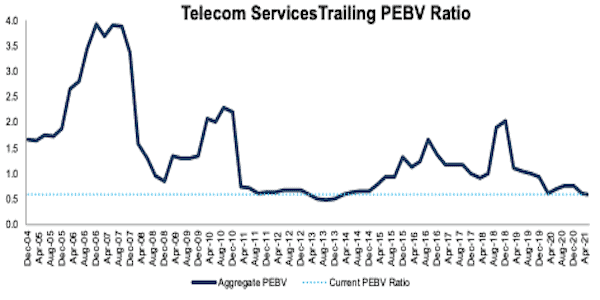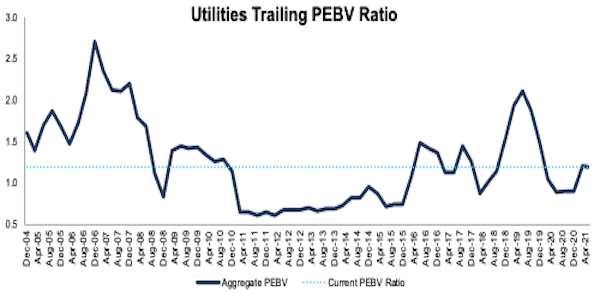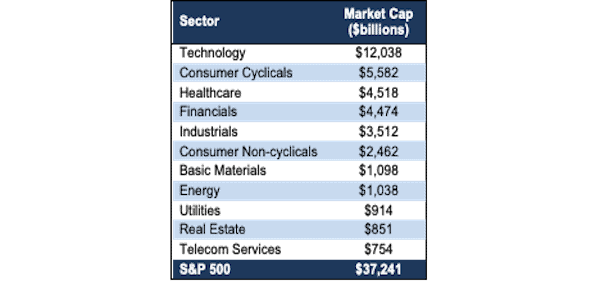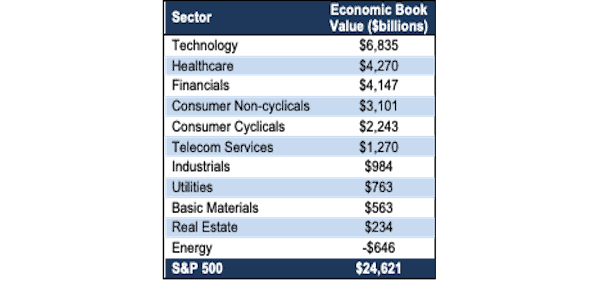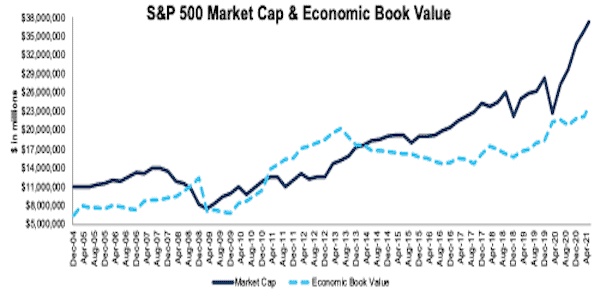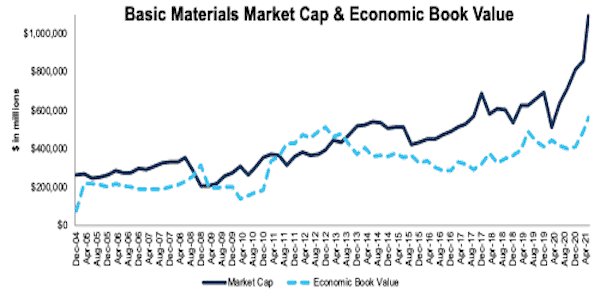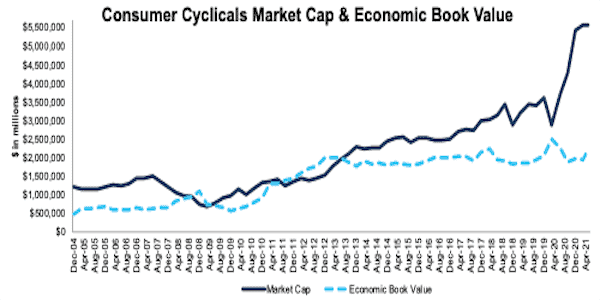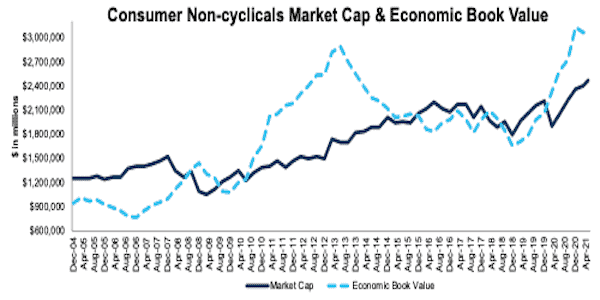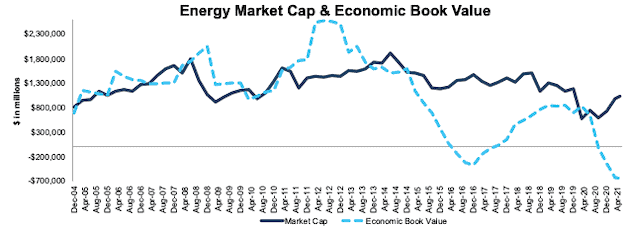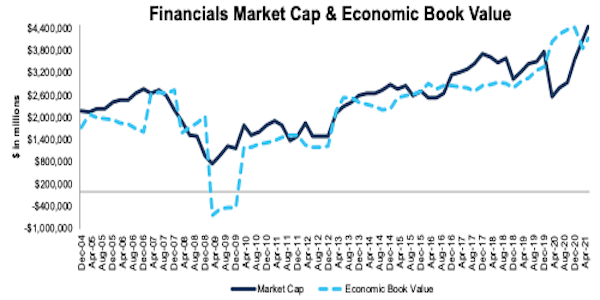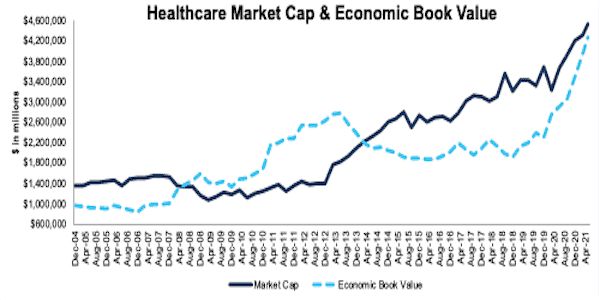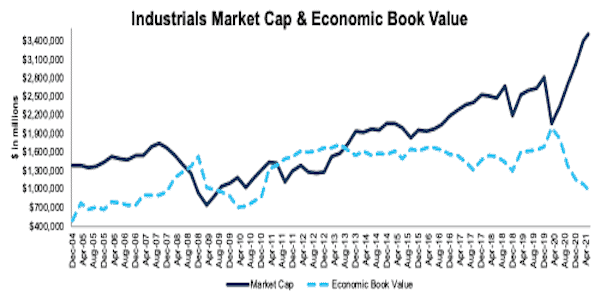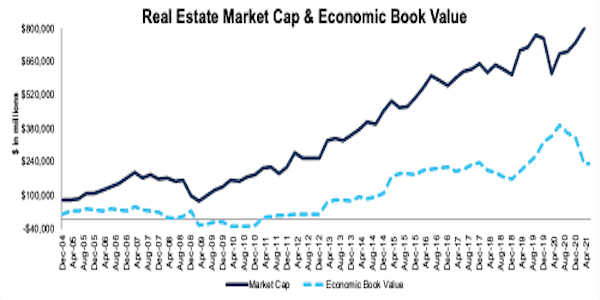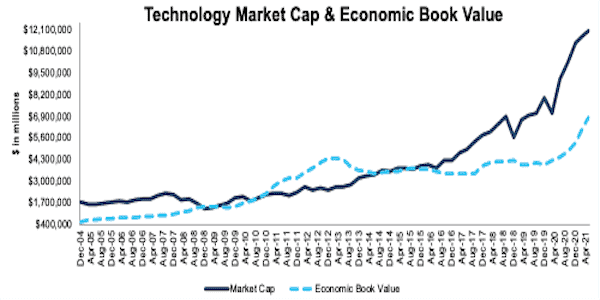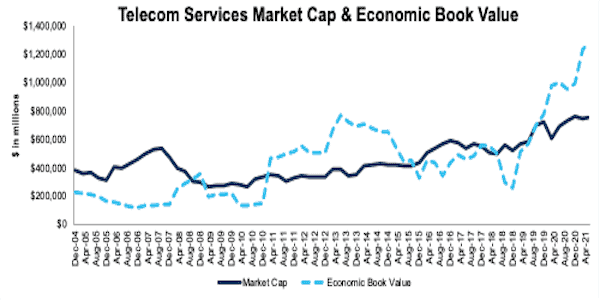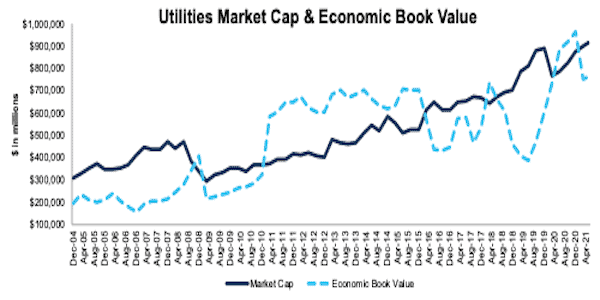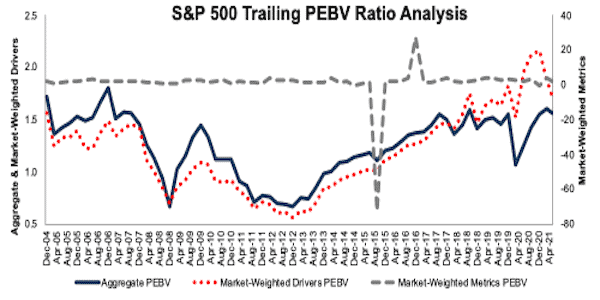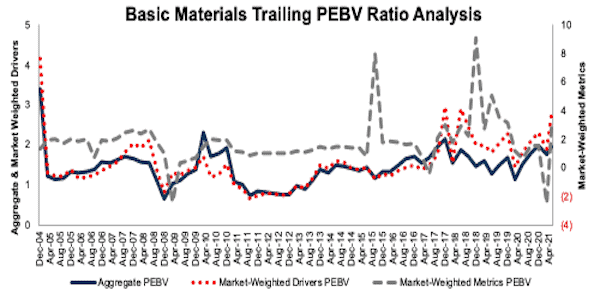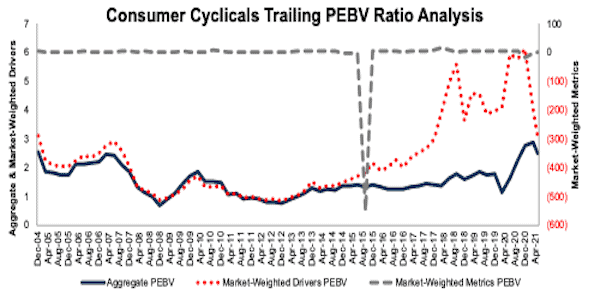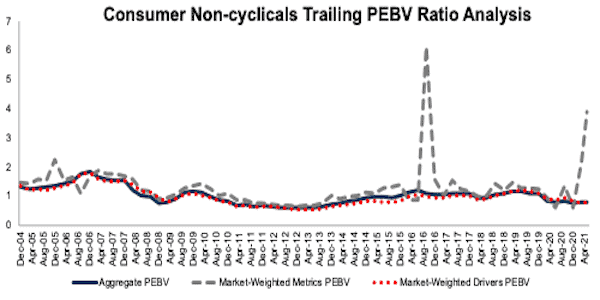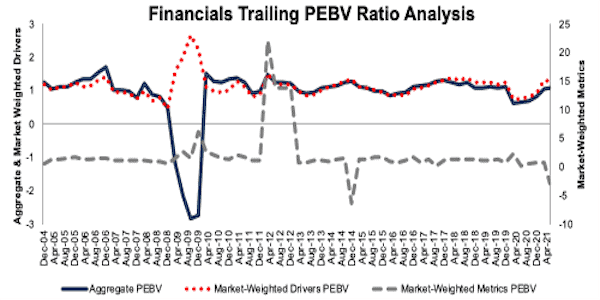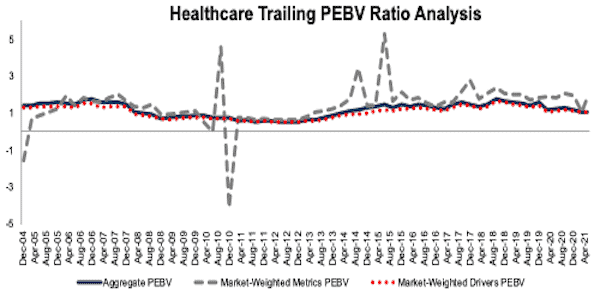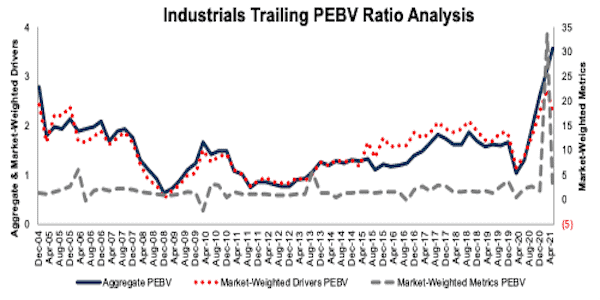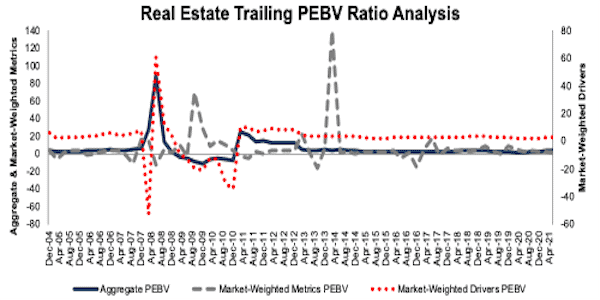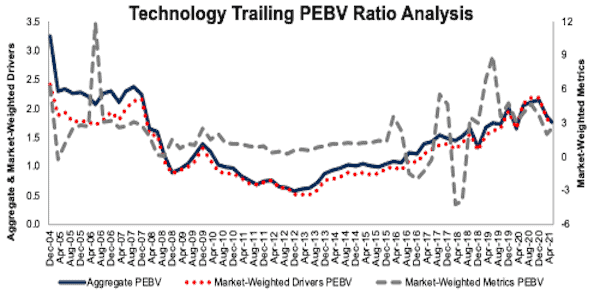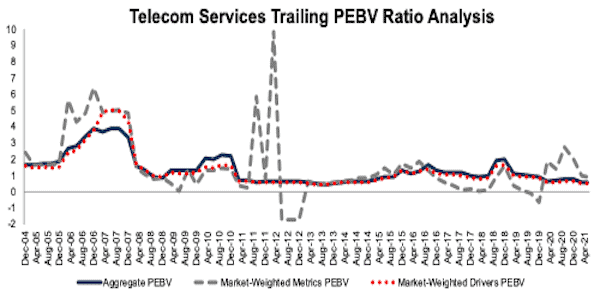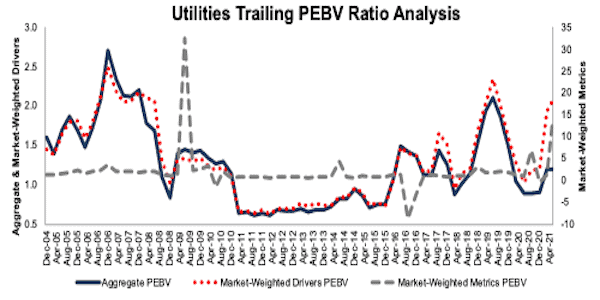This report analyzes[1] market cap, economic book value, and the trailing price-to-economic book value (PEBV) ratio for the S&P 500 and each of its sectors. In this report, our research is based on the latest audited financial data, which is the 2021 10-Q for most companies. Price data is as of 5/19/21.
We analyze other fundamental and valuation metrics for the S&P 500 and its sectors in these reports:
- Core Earnings for each S&P 500 sector: S&P 500 & Sectors: Core Earnings Vs. GAAP Net Income Through 1Q21
- Return on invested capital (ROIC) and its drivers for the S&P 500 and its sectors: S&P 500 & Sectors: ROIC vs. WACC Through 1Q21
- Free cash flow (FCF) yield and its drivers for the S&P 500 and its sectors: S&P 500 & Sectors: Free Cash Flow Yield Through 1Q21
These reports leverage more reliable fundamental data[2] that enables investors to overcome flaws with legacy fundamental datasets.
S&P 500 Trailing PEBV Ratio Has Risen Since 2019
The trailing PEBV ratio for the S&P 500 rose from 1.1 at the end of 2019 to 1.6 as of 5/19/21, the earliest date all S&P 500 companies provided 1Q21 quarterly data. The S&P 500 trailing PEBV ratio last reached this level in mid-2018 and in 4Q20, per Figure 1. At 1.6, the S&P 500’s valuation implies the profits of the S&P 500 will increase 60% from 1Q21 levels.
Figure 1: Trailing PEBV Ratio for the S&P 500 From December 2004 – 5/19/21[3]
Sources: New Constructs, LLC and company filings.
The May 19, 2021 measurement period uses price data as of that date and incorporates the financial data from 1Q21 10-Qs, as this is the earliest date for which all the 1Q21 10-Qs for the S&P 500 constituents were available.
Ranking All Sectors by Trailing Price to Economic Book Value Ratio (PEBV)
Two S&P 500 sectors trade below their economic book value (excluding Energy). Figure 2 shows the Telecom Services sector has the lowest trailing PEBV ratio among all 11 S&P 500 sectors based on prices as of 5/19/21 and financial data from 2021 10-Qs.
Figure 2: Trailing PEBV Ratios for all S&P 500 Sectors: 1Q20 to 1Q21
Sources: New Constructs, LLC and company filings.
Price as of 5/19/21, financial data incorporates 1Q21 10-Qs.
A PEBV ratio of 0.6 means the market expects the Telecom Services sector’s profits as of 1Q21 to decline by 40% from current levels. On the flip side, investors expect the Industrials and Real Estate sectors (trailing PEBV ratios of 3.6) to improve 1Q21 profits by 260% – more than any of the other S&P 500 sectors.
Details on Each of the S&P 500 Sectors
Figures 3-13 show the trailing PEBV ratio trends for every sector since 2004.
We present the components of the trailing PEBV ratio – market cap and economic book value – for the S&P 500 and each S&P 500 sector in Appendix I.
Appendix II provides additional aggregated trailing PEBV ratio analyses that adjusts for company size/market cap.
Basic Materials: Trailing PEBV Ratio = 1.9
Figure 3 shows the trailing PEBV ratio for the Basic Materials sector has fallen since 2017 but increased significantly in early 2020. The Basic Materials sector market cap rose from $636 billion in 1Q20 to $1.1 trillion in 1Q21, while its economic book value rose from $415 billion in 1Q20 to $563 billion in 1Q21.
Figure 3: Basic Materials Trailing PEBV Ratio: December 2004 – 5/19/21
Sources: New Constructs, LLC and company filings.
The May 19, 2021 measurement period uses price data as of that date and incorporates the financial data from 1Q21 10-Qs, as this is the earliest date for which all the 1Q21 10-Qs for the S&P 500 constituents were available.
Consumer Cyclicals: Trailing PEBV Ratio = 2.5
Figure 4 shows the trailing PEBV ratio for the Consumer Cyclicals sector in 1Q21 fell from its highest levels since the beginning of our analysis in 2004. The Consumer Cyclicals sector market cap rose from $3.7 trillion in 1Q20 to $5.6 trillion in 1Q21, while its economic book value fell from $2.3 trillion in 1Q20 to $2.2 trillion in 1Q21.
Figure 4: Consumer Cyclicals Trailing PEBV Ratio: December 2004 – 5/19/21
Sources: New Constructs, LLC and company filings.
The May 19, 2021 measurement period uses price data as of that date and incorporates the financial data from 1Q21 10-Qs, as this is the earliest date for which all the 1Q21 10-Qs for the S&P 500 constituents were available.
Consumer Non-cyclicals: Trailing PEBV Ratio = 0.8
Figure 5 shows the trailing PEBV ratio for the Consumer Non-cyclicals sector is still below recent highs from 2016-2019. The Consumer Non-cyclicals sector market cap rose from $2 trillion in 1Q20 to $2.5 trillion in 1Q21, while its economic book value rose from $2.6 trillion in 1Q20 to $3.1 trillion in 1Q21.
Figure 5: Consumer Non-cyclicals Trailing PEBV Ratio: December 2004 – 5/19/21
Sources: New Constructs, LLC and company filings.
The May 19, 2021 measurement period uses price data as of that date and incorporates the financial data from 1Q21 10-Qs, as this is the earliest date for which all the 1Q21 10-Qs for the S&P 500 constituents were available.
Energy: Trailing PEBV Ratio = -1.6
Figure 6 shows the COVID-19 impact on the Energy sector’s valuation, which results in a negative trailing PEBV in each of the past four quarters for the first time since mid-2017. The Energy sector market cap rose from $737 billion in 1Q20 to $1 trillion in 1Q21, while its economic book value fell from $648 billion in 1Q20 to -$646 billion in 1Q21. The large changes in 2014-2017 are driven by a large improvement in economic book value as oil prices, and therefore Energy firms’ profits, recovered from the precipitous fall in 2014-2016.
Figure 6: Energy Trailing PEBV Ratio: December 2004 – 5/19/21
Sources: New Constructs, LLC and company filings.
The May 19, 2021 measurement period uses price data as of that date and incorporates the financial data from 1Q21 10-Qs, as this is the earliest date for which all the 1Q21 10-Qs for the S&P 500 constituents were available.
Financials: Trailing PEBV Ratio = 1.1
Figure 7 shows trailing PEBV ratio for the Financials sector has been stable except for the Financial Crisis and has mostly been higher than current levels. The Financials sector market cap rose from $2.8 trillion in 1Q20 to $4.5 trillion in 1Q21, while its economic book value fell from $4.3 trillion in 1Q20 to $4.1 trillion in 1Q21.
Figure 7: Financials Trailing PEBV Ratio: December 2004 – 5/19/21
Sources: New Constructs, LLC and company filings.
The May 19, 2021 measurement period uses price data as of that date and incorporates the financial data from 1Q21 10-Qs, as this is the earliest date for which all the 1Q21 10-Qs for the S&P 500 constituents were available.
Healthcare: Trailing PEBV Ratio = 1.1
Figure 8 shows trailing PEBV ratio for the Healthcare sector is at its lowest level since 2014. Figure 8 also shows how cheap the Healthcare sector was during and after the Financial Crisis, trading below its economic book value from mid-2008 through 2013. The Healthcare sector market cap rose from $3.7 trillion in 1Q20 to $4.5 trillion in 1Q21, while its economic book value rose from $2.9 trillion in 1Q20 to $4.3 trillion in 1Q21.
Figure 8: Healthcare Trailing PEBV Ratio: December 2004 – 5/19/21
Sources: New Constructs, LLC and company filings.
The May 19, 2021 measurement period uses price data as of that date and incorporates the financial data from 1Q21 10-Qs, as this is the earliest date for which all the 1Q21 10-Qs for the S&P 500 constituents were available.
Industrials: Trailing PEBV Ratio = 3.6
Figure 9 shows the trailing PEBV ratio for the Industrials sector increased significantly since the end of 2019. The ratio is at its all-time high since the beginning of our analysis in December 2004 and shows that investors expect the sector’s profitability to rebound in a big way. The Industrials sector market cap rose from $2.1 trillion in 1Q20 to $3.5 trillion in 1Q21, while its economic book value fell from $2 trillion in 1Q20 to $983 billion in 1Q21.
Figure 9: Industrials Trailing PEBV Ratio: December 2004 – 5/19/21
Sources: New Constructs, LLC and company filings.
The May 19, 2021 measurement period uses price data as of that date and incorporates the financial data from 1Q21 10-Qs, as this is the earliest date for which all the 1Q21 10-Qs for the S&P 500 constituents were available.
Real Estate: Trailing PEBV Ratio = 3.6
Figure 10 shows the trailing PEBV ratio for the Real Estate sector is relatively stagnant save for the run up and crash around the Financial Crisis. The trailing sector PEBV is the highest since mid-2014. The Real Estate sector market cap rose from $695 billion in 1Q20 to $851 billion in 1Q21, while its economic book value fell from $391 billion in 1Q20 to $234 billion in 1Q21.
Figure 10: Real Estate Trailing PEBV Ratio: December 2004 – 5/19/21
Sources: New Constructs, LLC and company filings.
The May 19, 2021 measurement period uses price data as of that date and incorporates the financial data from 1Q21 10-Qs, as this is the earliest date for which all the 1Q21 10-Qs for the S&P 500 constituents were available.
Technology: Trailing PEBV Ratio = 1.8
Figure 11 shows the trailing PEBV ratio for the Technology sector, while still historically high compared to levels over the past decade, has fallen since 3Q20. Prior to 2019, the sector’s trailing PEBV ratio hadn’t reached current levels since 2007. The Technology sector market cap rose from $9.1 trillion in 1Q20 to $12 trillion in 1Q21, while its economic book value rose from $4.5 trillion in 1Q20 to $6.8 trillion in 1Q21.
Figure 11: Technology Trailing PEBV Ratio: December 2004 – 5/19/21
Sources: New Constructs, LLC and company filings.
The May 19, 2021 measurement period uses price data as of that date and incorporates the financial data from 1Q21 10-Qs, as this is the earliest date for which all the 1Q21 10-Qs for the S&P 500 constituents were available.
Telecom Services: Trailing PEBV Ratio = 0.6
Figure 12 shows the trailing PEBV ratio for the Telecom Services is at its lowest levels since the beginning of 2014. The Telecom Services sector market cap rose from $689 billion in 1Q20 to $754 billion in 1Q21, while its economic book value rose from $1 trillion in 1Q20 to $1.3 trillion in 1Q21.
Figure 12: Telecom Services Trailing PEBV Ratio: December 2004 – 5/19/21
Sources: New Constructs, LLC and company filings.
The May 19, 2021 measurement period uses price data as of that date and incorporates the financial data from 1Q21 10-Qs, as this is the earliest date for which all the 1Q21 10-Qs for the S&P 500 constituents were available.
Utilities: Trailing PEBV Ratio = 1.2
Figure 13 shows the volatile nature of the trailing PEBV ratio for the Utilities sector. Though it has risen from its mid-2020 lows, the sector’s trailing PEBV ratio is much lower than mid-2019 levels. The Utilities sector market cap rose from $785 billion in 1Q20 to $914 billion in 1Q21, while its economic book value fell from $886 billion in 1Q20 to $763 billion in 1Q21.
Figure 13: Utilities Trailing PEBV Ratio: December 2004 – 5/19/21
Sources: New Constructs, LLC and company filings.
The May 19, 2021 measurement period uses price data as of that date and incorporates the financial data from 1Q21 10-Qs, as this is the earliest date for which all the 1Q21 10-Qs for the S&P 500 constituents were available.
This article originally published on May 28, 2021.
Disclosure: David Trainer, Kyle Guske II, Alex Sword, and Matt Shuler receive no compensation to write about any specific stock, style, or theme.
Follow us on Twitter, Facebook, LinkedIn, and StockTwits for real-time alerts on all our research.
Appendix I: S&P 500: Market Cap & Economic Book Value Since 2004
This appendix shows the two drivers used to calculate trailing PEBV ratio – market cap and economic book value (EBV) – for the S&P 500 and each S&P 500 sector going back to December 2004. We sum the individual S&P 500/sector constituent values for market cap and economic book value. We call this approach the “Aggregate” methodology, and it matches S&P Global’s (SPGI) methodology for these calculations. More methodology details in Appendix II.
Figure 14 ranks all 11 sectors by market cap as of 5/19/21. It shows the Technology sector’s outsized impact on the S&P 500, with a market cap more than double the size of the next closest sector, Consumer Cyclicals.
Figure 14: Market Cap by Sector – as of 5/19/21
Sources: New Constructs, LLC and company filings.
Prices as of 5/19/21.
Figure 15 ranks all 11 sectors by economic book value based on financial data that incorporates 2021 10-Qs. It shows that the Technology sector also has the highest economic book value – though it’s not double the EBV of the next closest sector.
Figure 15: Economic Book Value by Sector – as of 5/19/21
Sources: New Constructs, LLC and company filings.
Financial data incorporates 2021 10-Qs.
Figures 16-27 compare the market cap and economic book value trends for the S&P 500 and every sector since 2004.
Note the much more prolonged price downturn during the Financial Crisis compared to the rapid recovery after the COVID-19-induced market crash.
Figure 16: S&P 500 Market Cap & Economic Book Value: December 2004 – 5/19/21
Sources: New Constructs, LLC and company filings.
The May 19, 2021 measurement period uses price data as of that date and incorporates the financial data from 1Q21 10-Qs, as this is the earliest date for which all the 1Q21 10-Qs for the S&P 500 constituents were available.
Figure 17: Basic Materials Market Cap & Economic Book Value: December 2004 – 5/19/21
Sources: New Constructs, LLC and company filings.
The May 19, 2021 measurement period uses price data as of that date and incorporates the financial data from 1Q21 10-Qs, as this is the earliest date for which all the 1Q21 10-Qs for the S&P 500 constituents were available.
Figure 18: Consumer Cyclicals Market Cap & Economic Book Value: December 2004 – 5/19/21
Sources: New Constructs, LLC and company filings.
The May 19, 2021 measurement period uses price data as of that date and incorporates the financial data from 1Q21 10-Qs, as this is the earliest date for which all the 1Q21 10-Qs for the S&P 500 constituents were available.
Figure 19: Consumer Non-cyclicals Market Cap & Economic Book Value: December 2004 – 5/19/21
Sources: New Constructs, LLC and company filings.
The May 19, 2021 measurement period uses price data as of that date and incorporates the financial data from 1Q21 10-Qs, as this is the earliest date for which all the 1Q21 10-Qs for the S&P 500 constituents were available.
Figure 20: Energy Market Cap & Economic Book Value: December 2004 – 5/19/21
Sources: New Constructs, LLC and company filings.
The May 19, 2021 measurement period uses price data as of that date and incorporates the financial data from 1Q21 10-Qs, as this is the earliest date for which all the 1Q21 10-Qs for the S&P 500 constituents were available.
Figure 21: Financials Market Cap & Economic Book Value: December 2004 – 5/19/21
Sources: New Constructs, LLC and company filings.
The May 19, 2021 measurement period uses price data as of that date and incorporates the financial data from 1Q21 10-Qs, as this is the earliest date for which all the 1Q21 10-Qs for the S&P 500 constituents were available.
Figure 22: Healthcare Market Cap & Economic Book Value: December 2004 – 5/19/21
Sources: New Constructs, LLC and company filings.
The May 19, 2021 measurement period uses price data as of that date and incorporates the financial data from 1Q21 10-Qs, as this is the earliest date for which all the 1Q21 10-Qs for the S&P 500 constituents were available.
Figure 23: Industrials Market Cap & Economic Book Value: December 2004 – 5/19/21
Sources: New Constructs, LLC and company filings.
The May 19, 2021 measurement period uses price data as of that date and incorporates the financial data from 1Q21 10-Qs, as this is the earliest date for which all the 1Q21 10-Qs for the S&P 500 constituents were available.
Figure 24: Real Estate Market Cap & Economic Book Value: December 2004 – 5/19/21
Sources: New Constructs, LLC and company filings.
The May 19, 2021 measurement period uses price data as of that date and incorporates the financial data from 1Q21 10-Qs, as this is the earliest date for which all the 1Q21 10-Qs for the S&P 500 constituents were available.
Figure 25: Technology Market Cap & Economic Book Value: December 2004 – 5/19/21
Sources: New Constructs, LLC and company filings.
The May 19, 2021 measurement period uses price data as of that date and incorporates the financial data from 1Q21 10-Qs, as this is the earliest date for which all the 1Q21 10-Qs for the S&P 500 constituents were available.
Figure 26: Telecom Services Market Cap & Economic Book Value: December 2004 – 5/19/21
Sources: New Constructs, LLC and company filings.
The May 19, 2021 measurement period uses price data as of that date and incorporates the financial data from 1Q21 10-Qs, as this is the earliest date for which all the 1Q21 10-Qs for the S&P 500 constituents were available.
Figure 27: Utilities Market Cap & Economic Book Value: December 2004 – 5/19/21
Sources: New Constructs, LLC and company filings.
The May 19, 2021 measurement period uses price data as of that date and incorporates the financial data from 1Q21 10-Qs, as this is the earliest date for which all the 1Q21 10-Qs for the S&P 500 constituents were available.
Appendix II: Analyzing Trailing PEBV Ratio with Different Weighting Methodologies
We derive the metrics above by summing the individual S&P 500/sector constituent values for market cap and economic book value to calculate trailing PEBV ratio. We call this approach the “Aggregate” methodology.
The Aggregate methodology provides a straightforward look at the entire S&P 500/sector, regardless of firm size or index weighting, and matches how S&P Global (SPGI) calculates metrics for the S&P 500.
For additional perspective, we compare the Aggregate method for trailing PEBV ratio with two other market-weighted methodologies. These market-weighted methodologies add more value for ratios that do not include market values, e.g. ROIC and its drivers, but we include them here, nonetheless, for comparison:
- Market-weighted metrics – calculated by market-cap-weighting the trailing PEBV ratio for the individual companies relative to their sector or the overall S&P 500 in each period. Details:
- Company weight equals the company’s market cap divided by the market cap of the S&P 500 or its sector
- We multiply each company’s trailing PEBV ratio by its weight
- S&P 500/Sector trailing PEBV equals the sum of the weighted trailing PEBV ratios for all the companies in the S&P 500/sector
- Market-weighted drivers – calculated by market-cap-weighting the market cap and economic book value for the individual companies in each sector in each period. Details:
- Company weight equals the company’s market cap divided by the market cap of the S&P 500 or its sector
- We multiply each company’s market cap and economic book value by its weight
- We sum the weighted market cap and weighted economic book value for each company in the S&P 500/each sector to determine the S&P 500 or sector’s weighted FCF and weighted enterprise value
- S&P 500/Sector trailing PEBV ratio equals weighted S&P 500/sector market cap divided by weighted S&P 500/sector economic book value
Each methodology has its pros and cons, as outlined below:
Aggregate method
Pros:
- A straightforward look at the entire S&P 500/sector, regardless of company size or weighting in any indices.
- Matches how S&P Global calculates metrics for the S&P 500.
Cons:
- Vulnerable to impact of companies entering/exiting the group of companies, which could unduly affect aggregate values. Also susceptible to outliers in any one period.
Market-weighted metrics method
Pros:
- Accounts for a firm’s market cap relative to the S&P 500/sector and weights its metrics accordingly.
Cons:
- Vulnerable to outlier results from a single company disproportionately impacting the overall trailing PEBV ratio, as we’ll show below.
Market-weighted drivers method
Pros:
- Accounts for a firm’s market cap relative to the S&P 500/sector and weights its size and economic book value accordingly.
- Mitigates the disproportionate impact of outlier results from one company on the overall results.
Cons:
- More susceptible to large swings in market cap or economic book value (which can be impacted by changes in WACC) period over period, particularly from firms with a large weighting in the S&P 500/Sector.
Figures 28-39 compare these three methods for calculating S&P 500 and sector trailing PEBV ratio. We provide some high-level commentary on why certain sectors show some interesting results. Clients can contact us for access to the underlying data to study the results in more detail.
In Figure 28, the sharp decline in the market-weighted metrics trailing PEBV for the S&P 500 in 2015 is driven largely by volatility in Amazon’s (AMZN) economic book value. The first instance was caused by a sharp decline in the firm’s net operating profit after-tax (NOPAT), coupled with an increase in weighted average cost of capital (WACC), which resulted in a negative economic book value and negative 16,606 trailing PEBV.
This analysis highlights the outsized sensitivity of the market-weighted metrics methodology to outlier results from a single company with a large market cap, such as Amazon.
Figure 28: S&P 500 Trailing PEBV Ratio Methodologies Compared: December 2004 – 5/19/21
Sources: New Constructs, LLC and company filings.
The May 19, 2021 measurement period uses price data as of that date and incorporates the financial data from 1Q21 10-Qs, as this is the earliest date for which all the 1Q21 10-Qs for the S&P 500 constituents were available.
Figure 29: Basic Materials Trailing PEBV Ratio Methodologies Compared: December 2004 – 5/19/21
Sources: New Constructs, LLC and company filings.
The May 19, 2021 measurement period uses price data as of that date and incorporates the financial data from 1Q21 10-Qs, as this is the earliest date for which all the 1Q21 10-Qs for the S&P 500 constituents were available.
In Figure 30, Amazon drives the sharp decline in the market-weighted metrics trailing PEBV for the Consumer Cyclicals Sector in 2015, as noted for S&P 500 above. The impacts are even larger on the sector-level results, as Amazon represented 10% of the sector in 2015.
Figure 30: Consumer Cyclicals Trailing PEBV Ratio Methodologies Compared: December 2004 – 5/19/21
Sources: New Constructs, LLC and company filings.
The May 19, 2021 measurement period uses price data as of that date and incorporates the financial data from 1Q21 10-Qs, as this is the earliest date for which all the 1Q21 10-Qs for the S&P 500 constituents were available.
In Figure 31, the sharp increase in the market-weighted metrics trailing PEBV for the Consumer Non-cyclicals sector in 2016, is driven by Kraft Heinz (KHC). The merger between Kraft and Heinz caused the combined firms’ economic book value to improve from -$15 billion in June 2016 to $1 billion in September 2016, which resulted in trailing PEBV rising from negative 7 to positive 98 over the same time. Given KHC’s 5% weight in the sector, this large change in trailing PEBV had an outsized impact on the sector’s market-weighted metrics trailing PEBV.
Figure 31: Consumer Non-cyclicals Trailing PEBV Ratio Methodologies Compared: December 2004 – 5/19/21
Sources: New Constructs, LLC and company filings.
The May 19, 2021 measurement period uses price data as of that date and incorporates the financial data from 1Q21 10-Qs, as this is the earliest date for which all the 1Q21 10-Qs for the S&P 500 constituents were available.
In Figure 32, the sharp increase in the market-weighted metrics trailing PEBV for the Energy sector in 2016, is driven largely by Exxon Mobil (XOM), which at the time, made up 25% of the sector’s market cap. As a result of crashing oil prices, Exxon Mobil’s NOPAT more than halved in 2015 and 2016 was still 41% below 2014. The significant decline in profitability caused an equally large drop in Exxon Mobil’s economic book value and resulted in XOM’s trailing PEBV increasing from 14 in June 2016 to 425 in December 2016. Given its large weighting in the sector, this increase had an outsized impact on the sector’s market-weighted metrics trailing PEBV during this time.
Figure 32: Energy Trailing PEBV Ratio Methodologies Compared: December 2004 – 5/19/21
Sources: New Constructs, LLC and company filings.
The May 19, 2021 measurement period uses price data as of that date and incorporates the financial data from 1Q21 10-Qs, as this is the earliest date for which all the 1Q21 10-Qs for the S&P 500 constituents were available.
Figure 33: Financials Trailing PEBV Ratio Methodologies Compared: December 2004 – 5/19/21
Sources: New Constructs, LLC and company filings.
The May 19, 2021 measurement period uses price data as of that date and incorporates the financial data from 1Q21 10-Qs, as this is the earliest date for which all the 1Q21 10-Qs for the S&P 500 constituents were available.
Figure 34: Healthcare Trailing PEBV Ratio Methodologies Compared: December 2004 – 5/19/21
Sources: New Constructs, LLC and company filings.
The May 19, 2021 measurement period uses price data as of that date and incorporates the financial data from 1Q21 10-Qs, as this is the earliest date for which all the 1Q21 10-Qs for the S&P 500 constituents were available.
Figure 35: Industrials Trailing PEBV Ratio Methodologies Compared: December 2004 – 5/19/21
Sources: New Constructs, LLC and company filings.
The May 19, 2021 measurement period uses price data as of that date and incorporates the financial data from 1Q21 10-Qs, as this is the earliest date for which all the 1Q21 10-Qs for the S&P 500 constituents were available.
Figure 36: Real Estate Trailing PEBV Ratio Methodologies Compared: December 2004 – 5/19/21
Sources: New Constructs, LLC and company filings.
The May 19, 2021 measurement period uses price data as of that date and incorporates the financial data from 1Q21 10-Qs, as this is the earliest date for which all the 1Q21 10-Qs for the S&P 500 constituents were available.
Figure 37: Technology Trailing PEBV Ratio Methodologies Compared: December 2004 – 5/19/21
Sources: New Constructs, LLC and company filings.
The May 19, 2021 measurement period uses price data as of that date and incorporates the financial data from 1Q21 10-Qs, as this is the earliest date for which all the 1Q21 10-Qs for the S&P 500 constituents were available.
Figure 38: Telecom Services Trailing PEBV Ratio Methodologies Compared: December 2004 – 5/19/21
Sources: New Constructs, LLC and company filings.
The May 19, 2021 measurement period uses price data as of that date and incorporates the financial data from 1Q21 10-Qs, as this is the earliest date for which all the 1Q21 10-Qs for the S&P 500 constituents were available.
Figure 39: Utilities Trailing PEBV Ratio Methodologies Compared: December 2004 – 5/19/21
Sources: New Constructs, LLC and company filings.
The May 19, 2021 measurement period uses price data as of that date and incorporates the financial data from 1Q21 10-Qs, as this is the earliest date for which all the 1Q21 10-Qs for the S&P 500 constituents were available.
[1] We calculate these metrics based on S&P Global’s (SPGI) methodology, which sums the individual S&P 500 constituent values for market cap and economic book value before using them to calculate the metrics. We call this the “Aggregate” methodology. Get more details in Appendices I and II.
[2] For 3rd-party reviews, including The Journal of Financial Economics, on our more reliable fundamental data, historically and prospectively, across all stocks, click here and here.
[3] We use stock prices from 5/19/21 because that is the date when all the 1Q21 10-Qs for the S&P 500 constituents were available.

